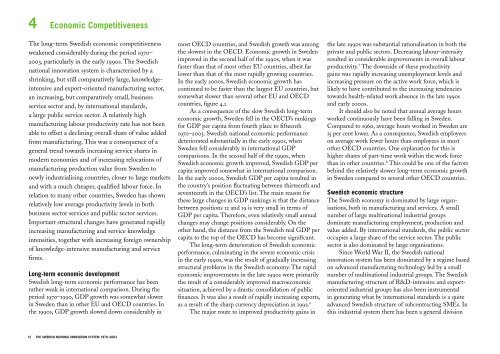The Swedish National Innovation System 1970-2003 - Vinnova
The Swedish National Innovation System 1970-2003 - Vinnova
The Swedish National Innovation System 1970-2003 - Vinnova
Create successful ePaper yourself
Turn your PDF publications into a flip-book with our unique Google optimized e-Paper software.
4 Economic Competitiveness<br />
<strong>The</strong> long-term <strong>Swedish</strong> economic competitiveness<br />
weakened considerably during the period <strong>1970</strong>–<br />
<strong>2003</strong>, particularly in the early 1990s. <strong>The</strong> <strong>Swedish</strong><br />
national innovation system is characterised by a<br />
shrinking, but still comparatively large, knowledgeintensive<br />
and export-oriented manufacturing sector,<br />
an increasing, but comparatively small, business<br />
service sector and, by international standards,<br />
a large public service sector. A relatively high<br />
manufacturing labour productivity rate has not been<br />
able to offset a declining overall share of value added<br />
from manufacturing. This was a consequence of a<br />
general trend towards increasing service shares in<br />
modern economies and of increasing relocations of<br />
manufacturing production value from Sweden to<br />
newly industrialising countries, closer to large markets<br />
and with a much cheaper, qualified labour force. In<br />
relation to many other countries, Sweden has shown<br />
relatively low average productivity levels in both<br />
business sector services and public sector services.<br />
Important structural changes have generated rapidly<br />
increasing manufacturing and service knowledge<br />
intensities, together with increasing foreign ownership<br />
of knowledge-intensive manufacturing and service<br />
firms.<br />
Long-term economic development<br />
<strong>Swedish</strong> long-term economic performance has been<br />
rather weak in international comparison. During the<br />
period <strong>1970</strong>–1990, GDP growth was somewhat slower<br />
in Sweden than in other EU and OECD countries. In<br />
the 1990s, GDP growth slowed down considerably in<br />
most OECD countries, and <strong>Swedish</strong> growth was among<br />
the slowest in the OECD. Economic growth in Sweden<br />
improved in the second half of the 1990s, when it was<br />
faster than that of most other EU countries, albeit far<br />
lower than that of the most rapidly growing countries.<br />
In the early 2000s, <strong>Swedish</strong> economic growth has<br />
continued to be faster than the largest EU countries, but<br />
somewhat slower than several other EU and OECD<br />
countries, figure 4.1.<br />
As a consequence of the slow <strong>Swedish</strong> long-term<br />
economic growth, Sweden fell in the OECD’s rankings<br />
for GDP per capita from fourth place to fifteenth<br />
<strong>1970</strong>–<strong>2003</strong>. <strong>Swedish</strong> national economic performance<br />
deteriorated substantially in the early 1990s, when<br />
Sweden fell considerably in international GDP<br />
comparisons. In the second half of the 1990s, when<br />
<strong>Swedish</strong> economic growth improved, <strong>Swedish</strong> GDP per<br />
capita improved somewhat in international comparison.<br />
In the early 2000s, <strong>Swedish</strong> GDP per capita resulted in<br />
the country’s position fluctuating between thirteenth and<br />
seventeenth in the OECD’s list. <strong>The</strong> main reason for<br />
these large changes in GDP rankings is that the distance<br />
between positions 12 and 19 is very small in terms of<br />
GDP per capita. <strong>The</strong>refore, even relatively small annual<br />
changes may change positions considerably. On the<br />
other hand, the distance from the <strong>Swedish</strong> real GDP per<br />
capita to the top of the OECD has become significant.<br />
<strong>The</strong> long-term deterioration of <strong>Swedish</strong> economic<br />
performance, culminating in the severe economic crisis<br />
in the early 1990s, was the result of gradually increasing<br />
structural problems in the <strong>Swedish</strong> economy. <strong>The</strong> rapid<br />
economic improvements in the late 1990s were primarily<br />
the result of a considerably improved macroeconomic<br />
situation, achieved by a drastic consolidation of public<br />
finances. It was also a result of rapidly increasing exports,<br />
as a result of the sharp currency depreciation in 1992. 6<br />
<strong>The</strong> major route to improved productivity gains in<br />
the late 1990s was substantial rationalisation in both the<br />
private and public sectors. Decreasing labour-intensity<br />
resulted in considerable improvements in overall labour<br />
productivity. 7 <strong>The</strong> downside of these productivity<br />
gains was rapidly increasing unemployment levels and<br />
increasing pressure on the active work force, which is<br />
likely to have contributed to the increasing tendencies<br />
towards health-related work absence in the late 1990s<br />
and early 2000s.<br />
It should also be noted that annual average hours<br />
worked continuously have been falling in Sweden.<br />
Compared to 1960, average hours worked in Sweden are<br />
15 per cent lower. As a consequence, <strong>Swedish</strong> employees<br />
on average work fewer hours than employees in most<br />
other OECD countries. One explanation for this is<br />
higher shares of part-time work within the work force<br />
than in other countries. 8 This could be one of the factors<br />
behind the relatively slower long-term economic growth<br />
in Sweden compared to several other OECD countries.<br />
<strong>Swedish</strong> economic structure<br />
<strong>The</strong> <strong>Swedish</strong> economy is dominated by large organisations,<br />
both in manufacturing and services. A small<br />
number of large multinational industrial groups<br />
dominate manufacturing employment, production and<br />
value added. By international standards, the public sector<br />
occupies a large share of the service sector. <strong>The</strong> public<br />
sector is also dominated by large organisations.<br />
Since World War II, the <strong>Swedish</strong> national<br />
innovation system has been dominated by a regime based<br />
on advanced manufacturing technology led by a small<br />
number of multinational industrial groups. <strong>The</strong> <strong>Swedish</strong><br />
manufacturing structure of R&D-intensive and exportoriented<br />
industrial groups has also been instrumental<br />
in generating what by international standards is a quite<br />
advanced <strong>Swedish</strong> structure of subcontracting SMEs. In<br />
this industrial system there has been a general division<br />
12 THE SWEDISH NATIONAL INNOVATION SYSTEM <strong>1970</strong>–<strong>2003</strong>

















